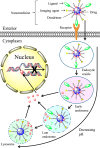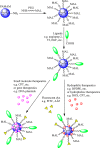Dendrimer advances for the central nervous system delivery of therapeutics
- PMID: 24274162
- PMCID: PMC3894720
- DOI: 10.1021/cn400182z
Dendrimer advances for the central nervous system delivery of therapeutics
Abstract
The effectiveness of noninvasive treatment for central nervous system (CNS) diseases is generally limited by the poor access of therapeutic agents into the CNS. Most CNS drugs cannot permeate into the brain parenchyma because of the blood-brain barrier (BBB), and overcoming this has become one of the most significant challenges in the development of CNS therapeutics. Rapid advances in nanotechnology have provided promising solutions to this challenge. This review discusses the latest applications of dendrimers in the treatment of CNS diseases with an emphasis on brain tumors. Dendrimer-mediated drug delivery, imaging, and diagnosis are also reviewed. The toxicity, biodistribution, and transport mechanisms in dendrimer-mediated delivery of CNS therapeutic agents bypassing or crossing the BBB are also discussed. Future directions and major challenges of dendrimer-mediated delivery of CNS therapeutic agents are included.
Figures



Similar articles
-
Nanotechnological advances for the delivery of CNS therapeutics.Adv Drug Deliv Rev. 2012 May 15;64(7):686-700. doi: 10.1016/j.addr.2011.10.007. Epub 2011 Nov 7. Adv Drug Deliv Rev. 2012. PMID: 22100125 Review.
-
Nanomaterial applications for neurological diseases and central nervous system injury.Prog Neurobiol. 2017 Oct;157:29-48. doi: 10.1016/j.pneurobio.2017.07.003. Epub 2017 Jul 22. Prog Neurobiol. 2017. PMID: 28743465 Review.
-
Targeted delivery of nano-therapeutics for major disorders of the central nervous system.Pharm Res. 2013 Oct;30(10):2485-98. doi: 10.1007/s11095-013-1122-4. Pharm Res. 2013. PMID: 23797465 Review.
-
Applications of nanotechnology in drug delivery to the central nervous system.Biomed Pharmacother. 2019 Mar;111:666-675. doi: 10.1016/j.biopha.2018.12.133. Epub 2019 Jan 3. Biomed Pharmacother. 2019. PMID: 30611991 Review.
-
Nanomaterial-mediated CNS delivery of diagnostic and therapeutic agents.Adv Drug Deliv Rev. 2012 May 15;64(7):605-13. doi: 10.1016/j.addr.2011.11.014. Epub 2011 Dec 8. Adv Drug Deliv Rev. 2012. PMID: 22178615 Free PMC article. Review.
Cited by
-
Breaking Barriers: Bioinspired Strategies for Targeted Neuronal Delivery to the Central Nervous System.Pharmaceutics. 2020 Feb 23;12(2):192. doi: 10.3390/pharmaceutics12020192. Pharmaceutics. 2020. PMID: 32102252 Free PMC article. Review.
-
Potential applications of magnetic particles to detect and treat Alzheimer's disease.Nanoscale Res Lett. 2014 Oct 1;9(1):538. doi: 10.1186/1556-276X-9-538. eCollection 2014. Nanoscale Res Lett. 2014. PMID: 25288921 Free PMC article.
-
Veterinary nanomedicine: Pros and cons.Vet Med Sci. 2023 Jan;9(1):494-506. doi: 10.1002/vms3.1050. Epub 2022 Dec 29. Vet Med Sci. 2023. PMID: 36580403 Free PMC article. Review.
-
Neurosurgery at the crossroads of immunology and nanotechnology. New reality in the COVID-19 pandemic.Adv Drug Deliv Rev. 2022 Feb;181:114033. doi: 10.1016/j.addr.2021.114033. Epub 2021 Nov 20. Adv Drug Deliv Rev. 2022. PMID: 34808227 Free PMC article. Review.
-
Advances in the design of solid lipid nanoparticles and nanostructured lipid carriers for targeting brain diseases.J Control Release. 2017 Oct 28;264:306-332. doi: 10.1016/j.jconrel.2017.08.033. Epub 2017 Aug 26. J Control Release. 2017. PMID: 28844756 Free PMC article. Review.
References
-
- Barchet T. M.; Amiji M. M. (2009) Challenges and opportunities in CNS delivery of therapeutics for neurodegenerative diseases. Expert Opin. Drug Delivery 6, 211–225. - PubMed
-
- Tiwari S. B.; Amiji M. M. (2006) A review of nanocarrier-based CNS delivery systems. Curr. Drug Delivery 3, 219–232. - PubMed
-
- DiNunzio J. C.; Williams R. O. 3rd (2008) CNS disorders–current treatment options and the prospects for advanced therapies. Drug Dev. Ind. Pharm. 34, 1141–1167. - PubMed
Publication types
MeSH terms
Substances
LinkOut - more resources
Full Text Sources
Other Literature Sources

